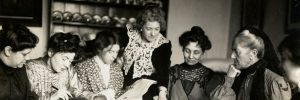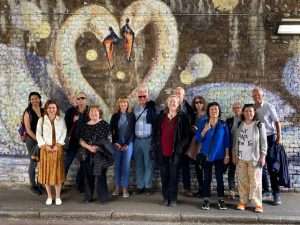Once a prominent fixture in London’s thriving theatrical scene and was a venue known for its rich history and captivating productions. Positioned next to Westminster Abbey, the theatre was initially opened as the Aquarium Theatre in 1876 before undergoing extensive renovations and reopening as the Imperial Theatre in 1901. The stunning architecture and design, combined with a series of groundbreaking performances, made the Imperial Theatre a focal point for London’s cultural and social life during the early 20th century.
Architectural Evolution and Reconstruction on the Imperial Theatre
The Aquarium Theatre, designed by Alfred Bedborough and built by Messrs Lucas, initially had a capacity of 1,293. Walter Emden carried out extensive alterations in 1898. The original theatre remained in use until it was taken over by Lily Langtry in 1900. Frank T. Verity reconstructed the theatre in 1901, renaming it the Imperial Theatre and reducing its capacity to 1,150.
As reported by The Builder on April 27, 1901, the reconstruction under Lily. Langtry’s personal direction saw the complete overhaul of the theatre, including a new roof, auditorium, staircases, foyers, stage, and a modern electric lighting system. The new design featured a purely architectural character, with marble and burnished metal dominating the materials employed.
The Imperial Theatre hosted a variety of captivating productions, including:
“A Man of His Word” (1901) a military in three acts by Boyle Lawrence. Henry Irving played Colonel Sir Philip Pangdon, Cecil Raleigh and Herbert Waring were also members of the cast.
The Crossways
In 1902, Lily Langtry produced and starred in The Crossways, showcasing her immense talents and furthering her impact on the theatrical landscape. The play was a gripping drama that explored themes of love, betrayal, and redemption. Set against a backdrop of Victorian society, The Crossways delved into the complexities of human relationships and the choices people make when faced with difficult circumstances.
Langtry’s performance in the leading role was widely praised, with critics and audiences alike lauding her nuanced portrayal of a strong, independent woman. Her commanding stage presence and ability to connect with the audience made The Crossways a memorable theatrical experience.
“Mrs Langtry’s final appearance on the stage prior to her American tour was made last night under exceptional and brilliant circumstances. The King’s unique command to Mrs Langtry to give a special performance of her latest play, “The Crossways,” of which she is part author, at the Imperial theatre, started tongues wagging. Never before has a performance by royal command of any play been given in a public theatre. Society is saying it was a most gracious act on the part of the King toward Mrs Langtry, who has had hard luck since she opened her magnificent playhouse. At all events, no recent production has aroused the interest of this one. It had been intended to give a private performance of the play, which has already been produced with success In the provinces, but it was decided to make it a semi-public affair. All the unreserved seats were distributed among the servants of the royal household, and the remainder of the house which was not occupied by members of the royal family and their suites was sold privately to the elite of London society.
The King, Queen Alexandra, the Prince of Wales and their suites arrived at 9 o’clock and without any formality were conducted to a box on the right of the stage. In the opposite box sat the Portuguese minister, Lady De Grey, Count Mensdorf, the first Secretary of the Austrian legation, and others, while the brilliant audience included the Countess of Errol, Lord Churchill, Mrs Ronalds and many Americans. Three hundred and eight royal servants and their families were present. The plot of the piece is a rather hackneyed one, but Mrs Langtry’s acting appeared to greatly please the Royal visitors, who remained to the end. In the interval between the third and fourth acts the royal party moved to the anteroom for refreshments and the King then commanded Mrs Langtry’s presence and commended the play very warmly. Queen Alexandra said to Mrs Langtry: “I am extremely pleased with the play. I think it is most dramatic and I am sure you will have great success.”
Mrs Langtry’s dresses were very beautiful. She had a hearty recall at the close of the performance. The Daily Northwestern (Oshkosh), 19th December 1902.
Notable Productions at the Imperial Theatre
‘The Perfect Lover’ (1905): A programme and picture album were produced for this production.
Les Hannetons (1906 – 1907)
Les Hannetons was a French comedy play that enjoyed a successful run at the Imperial Theatre from 1906 to 1907. The play, written by Eugène Brieux, was a humorous exploration of social and political issues of the time.
The Imperial Theatre in London presented a captivating production of Eugène Brieux’s French drama, Les Hannetons, between 1906 and 1907. Mounted by the Incorporated Stage Society, the play featured an impressive array of actors and crew members, all collaborating to bring Brieux’s work to life under the direction of Janet Achurch.
Cast & Crew:
Florence Adale (also in Der Kammersänger)
Dora Barton (London-born actress. Daughter of actress Mary Barton and the sister of actress Naomi Barton.)
Lola Duncan (Scottish actress best known for Mr Bill the Conqueror (1932), Self Made Lady (1932) and Once a Thief (1935))
C V France (Yorkshire actor. Best known for The Skin Game (1931), If I Were King (1938) and Went the Day Well? (1942) senior military officers, aged aristocrats and a crusty magistrate).
Edmund Gwenn (also in Der Kammersänger)
Mabel Hackney (Welsh actress, wife of the dramatist and actor Laurence Irving and daughter-in-law of the actor Henry Irving)
Nigel Playfair (London-born actor. Later became actor-manager of the Lyric Theatre, Hammersmith, in the 1920s.)
Kenneth Rivington (had just finished playing Sherlock Holmes on stage)
Asheton Tonge (London-born child actor)
Der Kammersanger (1906 – 1907)
“Der Kammersanger” was a German play that graced the stage of the Imperial Theatre from 1906 to 1907. The play, a fascinating blend of drama and music, followed the life of a famous opera singer and his romantic entanglements. The production was praised for its powerful performances and captivating storyline, attracting a diverse audience who appreciated both its dramatic and musical elements.
Der Kammersänger, also known as The Court Singer, is a satirical comedy by Frank Wedekind. The play revolves around the life of a renowned opera singer who becomes entangled in a web of intrigues and scandals. Through humour and biting wit, Wedekind explores themes of fame, ambition, and the pursuit of personal desires in the face of societal expectations.
The production of Der Kammersänger at the Imperial Theatre brought together an exceptional cast and crew who collaborated to create a memorable theatrical experience. Directed by Frank Reicher, the play featured a diverse group of actors, including:
Florence Adale (also in Les Hannetons)
Irene Clarke
Constance Collier (most of her stage performances were at Her Majesty’s Theatre)
C R Gibbon
Edmund Gwenn (Born Edmund John Kellaway He was the brother of actor Arthur Chesney. Just starting out in his career with this being his second production)
A B Imeson (Yorkshire actor best known for Dicky Monteith (1922), Tense Moments from Opera (1922) and The Picture of Dorian Gray (1916))
Julien L’Estrange (was also in The Vikings and made a handful of silent films for Paramount Pictures)
Alys Rees
James R Sinclair
Brigadier Gerard (1906)
“Brigadier Gerard,” which premiered on 3rd March 1906, was a thrilling stage adaptation of Sir Arthur Conan Doyle’s series of historical short stories. Set during the Napoleonic Wars, the play followed the adventures of the titular character, Brigadier Gerard, a courageous and loyal French soldier. The production was lauded for its exciting action sequences, intriguing plot, and compelling performances, drawing in audiences who relished the opportunity to witness a piece of historical fiction come to life on stage.
The Vikings (1902 – 1903)
“The Vikings,” was staged at the Imperial Theatre from 1902 to 1903. It is a historical drama by Ibsen that explores the lives and adventures of Viking warriors during the 10th century. The play delves into themes of power, ambition, love, and betrayal, set against the backdrop of the Viking age. Performances began at 8.30pm
The production of The Vikings at the Imperial Theatre showcased the talents of a remarkable cast and crew, who brought Ibsen’s vision to life on the London stage. Directed by Edward Gordon Craig, the play featured a diverse ensemble of actors, including:
Oscar Asche (an Australian actor, director, and writer, best known for having written, directed, and acted in the record-breaking musical Chu Chin Chow)
Nelly Hutin Britton (best known for her performances in Shakespeare roles early in the 20th century. She also appeared in leading roles in two silent British films.)
Hubert Carter (a Yorkshire actor best known for Ivanhoe (1913), London (1926) and The Wonderful Year (1921)
E Holman Clark (famous for his annual Christmas performance as Captain Hook in J.M. Barrie’s Peter Pan.)
Noel Compton (child actor)
Mark Kinghorne (a comedian and character actor with considerable success in many West End theatres)
Julien L’Estrange (made a handful of silent films for Paramount Pictures)
Conway Tearle (American actor, the son of the well-known British-born cornetist Jules Levy and American actress Marianne “Minnie” Conway.)
Charles Terry (Ellen Terry’s brother)
Ellen Terry
The Imperial Theatre’s Demise and Legacy
The Imperial Theatre was closed and demolished on November 24, 1907. The site, along with the Royal Aquarium site, became home to the new Methodist Central Hall in 1912.
Remarkably, before demolition, the interior of the Imperial Theatre, which had been rebuilt in 1901, was saved and re-erected as the Imperial Palace of Varieties in Canning Town. This represented a rebuilding of the old Royal Albert Music Hall there, reopening in December 1909. This was destroyed in 1831 in a fire. The site of the Royal Aquarium and Imperial Theatre is now occupied by Westminster Central (Methodist) Hall.





